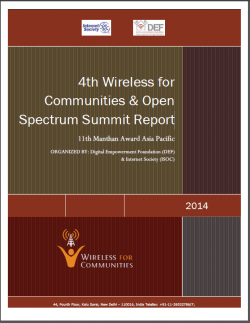In December 2014, the Internet Society sought to flesh out persisting challenges to rural connectivity, and found that a diversified ISP sector, along with local loop unbundling, are integral to ensuring equitable and affordable Internet access in India. The annual multi-stakeholder summit, organised by ISOC and Delhi-based Digital Empowerment Foundation, is part of our ongoing Wireless for Communities programme, which enables rural communities around India to build and operate their own wireless networks using low-cost technology and unlicensed spectrum.
Below are some of the key recommendations which came out of the forum:
1. The government should develop a policy framework and licensing regime that makes possible the establishment rural ISPs as a legitimate business entity. Such village-level enterprises will not only facilitate the creation of new models for universal access, but would also reduce users’ dependence on bigger players. This can be complemented by rules that mandate telecom firms to share their infrastructure, such as their points of presence, to new entrants, and a streamlined system for the acquisition of required government permits, which remain costly and time-consuming.
2. District panchayats or self-help groups in India can invest in village level infrastructure, using funding from such sources as the Backward Region Grants Fund. This is already being done in towns like Sabarkantha in Gujarat, which has appointed an ISP to run its community network on a revenue-sharing agreement.
3. The private sector should create service models specifically for running rural Internet networks, while the Universal Service Obligation Fund (USO Fund) should be used to incentivize ISPs whenever there is a funding gap. The government could also opt to reduce ISPs’ USO payments in exchange for their investment in non-commercially viable areas.
